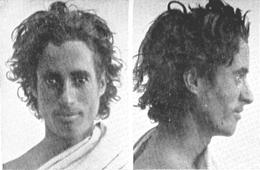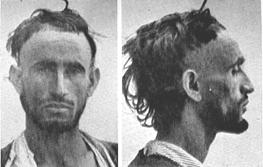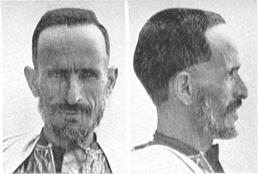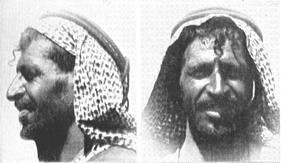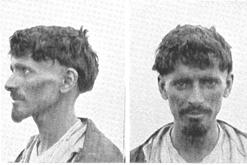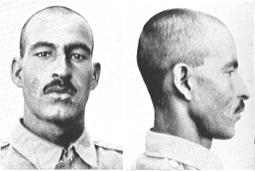|
(Photographic Supplement, Plate 16)
FIG. 2 (2 views). Another Yemeni highlander, in this case from the escarpment tribe of Beni Madhar. This man is shorter in stature, and much longer-headed. He is mixed in eye color; some 25 per cent of all pure brunet Mediterranean groups possess a trace of incipient blondism. The cranial and facial dimensions of this individual resemble those of the larger, Atlanto-Mediterranean strain as found in western Europe and North Africa. In Arabia the two are not clearly differentiated.
FIG. 3 (2 views). A Yemeni soldier from the tribe of Khaulan, which goes back historically to Sabaean times. Metrically a perfect Mediterranean central type, this individual possesses a thin, aquiline nose of a type found frequently but by no means exclusively among Arabs.
FIG. 4 (2 views, photo Henry Field. Courtesy of the Field Museum of Natural History, Chicago). A Ruwalla Bedawin, a member of an aristocratic tribe of camel breeders who inhabit the Syrian desert. The Ruwalla, more brunet than the Yemenis, resemble them closely in most respects.
FIG. 5 (2 views, photo Henry Field. Courtesy of the Field Museum of Natural History, Chicago). A Solubbi; member of a small group of desert wanderers and outcasts who inhabit the North Arabian desert, travelling in small family groups and serving as hunters and tinkers for the Bedawin. They are the purest Mediterraneans in northern Arabia, and probably represent an extremely ancient element in the North Arabian population. This Solubbi may be considered a classical Mediterranean.
FIG. 6 (2 views, photo Henry Field. From Field, Henry, Arabs of Central Iraq, Anth. Mem. of the Field Museum of Natural History, vol. 4, 1935, Plate LXXX). A tall Mediterranean from Iraq. The Iraqians, who are apparently direct and unaltered descendants of the ancient Mesopotamians, are Mediterraneans. They are, however, on the whole taller, darker-skinned, longer-faced, and straighter-haired than the Arabs.
|
